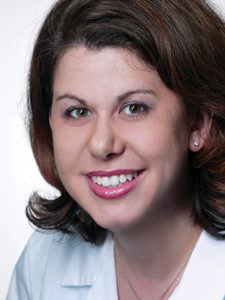
Clinicians facing diagnostic and therapeutic dilemmas, particularly when dealing with rare and complex diseases where there may be a paucity of data from controlled studies, often turn to experts in those fields for consultation.
In that spirit, the ACR session Curbside Consults on Sunday will feature a panel of experts who will share current science and best practices in the diagnosis and management of three challenging conditions. The session will be held from 4:30 – 6:00 pm in Room W375b.
Roberta Ramonda, MD, PhD, a rheumatologist in the Department of Medicine at the University of Padova in Italy, will discuss the clinical presentation and treatment approaches in erosive/inflammatory osteoarthritis, with a specific focus on erosive hand osteoarthritis (EHOA).
“Erosive hand osteoarthritis is usually defined as a clinically more severe subset of hand osteoarthritis (HOA), even though some authors have argued that EHOA should be considered a stand-alone entity rather than a progression of HOA,” Dr. Ramonda said.
The term “erosive osteoarthritis” was coined in 1966 (Peter JB et al. Erosive Arthritis of the Hands. Arthritis & Rheum 1966 June), Dr. Ramonda said, but there is no consensus on validated diagnostic or classification criteria for EHOA.
EHOA affects predominantly young adult females, she said, and other frequent risk factors for EHOA include positive family history, obesity, and smoking. The condition is characterized by distal and proximal interphalangeal joints, abrupt onset, marked pain, functional impairment, and inflammatory clinical and serological features such as stiffness, soft tissue swelling, and mild ultrasensitive C-reactive protein elevation.
“The pathognomonic radiological sign is the central joint erosion, while other radiological features include cortical destruction, central bone crumbling erosion, and subsequent reparative changes, such as bony ankylosis and osteophytes,” Dr. Ramonda said. “Erosions result in peculiar deformities — the so-called ‘seagull-wing’ or ‘saw-tooth’ patterns. MRI may detect synovial effusion and bone oedema whose location could be influenced by collateral ligament abnormalities.”
With no specific treatment guidelines currently available for EHOA, Dr. Ramonda said, current treatments are usually derived from non-erosive HOA treatment guidelines. Ongoing research is attempting to identify specific biomarkers that may prove useful in disease diagnosis and monitoring.
“EHOA definition should take into account demographic data — such as genetic predisposition, age, gender, BMI, etc. — as well as clinical and radiological features,” she said. “Moving forward, a validated and a universal consensus on the definition of EHOA is needed to better characterize patients and identify possible treatments.”

Looking at another challenging clinical scenario, Jill P. Buyon, MD, will discuss risk assessment and risk mitigation of neonatal lupus when a pregnant woman is found seropositive for autoantibodies to SSA/Ro and SSB/La. Dr. Buyon is Professor of Medicine, Director of the Division of Rheumatology, and Director of the Lupus Center at New York University School of Medicine/New York University Langone Health.
“The potential that these antibodies can cause harm in the fetus needs to be recognized by rheumatologists because we are often the physicians asked to provide advice to these women,” Dr. Buyon said. “If a pregnant woman, regardless of what disease she may have, is identified to have anti-SSA/Ro antibodies, there is a 2 percent chance that the child may have a permanent condition called congenital heart block.”
Dr. Buyon and her colleague, Peter Izmirly, MD, are leading a large national study to evaluate whether hydroxychloroquine reduces the recurrence rate of congenital heart block. A positive result would also have important implications for primary prevention.
“The problem when you have a rare disease is that not many clinicians have seen patients with it and often the literature is limited to anecdotal reports. Our group has been studying the clinical and basic aspects of neonatal lupus for over two decades,” she said. “Over that time, we have built the world’s largest extant registry of women and their children affected by neonatal lupus, which can also affect the skin, liver, and blood cells, as well as the heart.”
Dr. Buyon said pregnant patients who test positive for anti-SSA/Ro antibodies should be surveilled closely, including weekly echocardiograms, and that rheumatologists should work in cooperation with maternal fetal medicine and pediatric cardiology colleagues to manage these patients. She will also discuss new ways mothers can participate in surveillance with simple daily home monitoring.

In the final presentation of the session, Lisa Christopher-Stine, MD, MPH, Associate Professor of Medicine and Neurology Director of the Johns Hopkins Myositis Center at Johns Hopkins University School of Medicine in Baltimore, will talk about the challenges in diagnosing and managing patients with antisynthetase syndrome.
“Antisynthetase syndrome is a constellation of having one of the antisynthetase autoantibodies in combination with what are usually the main features — myositis, interstitial lung disease, and arthritis,” Dr. Christopher-Stine said. “Additional features may include mechanic’s hands, fever, Raynaud’s phenomenon, and skin rash.”
She said that since the main features of the syndrome may present in succession rather than concomitantly, predicting these features and catching them early could lead to better patient outcomes and survival.
“While there are no specific treatment guidelines, current practices can be extrapolated from studies in which specific autoantibody groups can be studied in isolation to determine their response to individual therapies,” she said. “Additionally, each active feature of the syndrome may be ascertained and be treated accordingly.”


